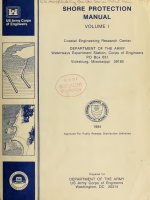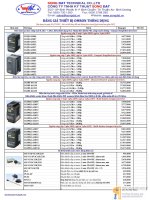mrisequences 130118064505 phpapp02
Bạn đang xem bản rút gọn của tài liệu. Xem và tải ngay bản đầy đủ của tài liệu tại đây (3.14 MB, 99 trang )
MRI SEQUENCES
Tushar Patil, MD
Senior Resident
Department of Neurology
King George’s Medical University
Lucknow, India
MRI PRINCIPLE
MRI is based on the principle of nuclear magnetic resonance (NMR)
Two basic principles of NMR
1. Atoms with an odd number of protons or neutrons have spin
2. A moving electric charge, be it positive or negative, produces a magnetic field
Body has many such atoms that can act as good MR nuclei (1H, 13C, 19F, 23Na)
Hydrogen nuclei is one of them which is not only positively charged, but also has magnetic spin
MRI utilizes this magnetic spin property of protons of hydrogen to elicit images
WHY HYDROGEN IONS ARE USED IN
MRI?
Hydrogen nucleus has an unpaired proton which is positively charged
Every hydrogen nucleus is a tiny magnet which produces small but noticeable magnetic field
Hydrogen atom is the only major species in the body that is MR sensitive
Hydrogen is abundant in the body in the form of water and fat
Essentially all MRI is hydrogen (proton) imaging
BODY IN AN EXTERNAL MAGNETIC
FIELD (B0)
•In our natural state Hydrogen ions in body are
spinning in a haphazard fashion, and cancel all
the magnetism.
•When an external magnetic field is applied protons
in the body align in one direction. (As the compass
aligns in the presence of earth’s
magnetic field)
NET MAGNETIZATION
Half of the protons align along the magnetic field and rest are aligned opposite
.
At room temperature, the
population ratio of antiparallel versus parallel
protons is roughly 100,000
to 100,006 per Tesla of B0
These extra protons produce net magnetization vector (M)
Net magnetization depends on B0 and temperature
MANIPULATING THE NET
MAGNETIZATION
Magnetization can be manipulated by changing the magnetic field environment (static, gradient, and RF fields)
RF waves are used to manipulate the magnetization of H nuclei
Externally applied RF waves perturb magnetization into different axis (transverse axis). Only transverse magnetization produces
signal.
When perturbed nuclei return to their original state they emit RF signals which can be detected with the help of receiving coils
T1 AND T2 RELAXATION
When RF pulse is stopped higher energy gained by proton is retransmitted and hydrogen nuclei relax by two mechanisms
T1 or spin lattice relaxation- by which original magnetization (Mz) begins to recover.
T2 relaxation or spin spin relaxation - by which magnetization in X-Y plane decays towards zero in an exponential fashion. It is
due to incoherence of H nuclei.
T2 values of CNS tissues are shorter than T1 values
T1 RELAXATION
After protons are
Excited with RF pulse
They move out of
Alignment with B
0
But once the RF Pulse
is stopped they Realign
after some Time And
this is called t1 relaxation
T1 is defined as the time it takes for the hydrogen nucleus to recover 63% of its longitudinal magnetization
T2 relaxation time is the time for 63% of the protons to become dephased
owing to interactions among nearby protons.
TR AND TE
TE (echo time) : time interval in which signals are measured after RF excitation
TR (repetition time) : the time between two excitations is called repetition time
By varying the TR and TE one can obtain T1WI and T2WI
In general a short TR (<1000ms) and short TE (<45 ms) scan is T1WI
Long TR (>2000ms) and long TE (>45ms) scan is T2WI
Long TR (>2000ms) and short TE (<45ms) scan is proton density image
Different tissues have different relaxation times. These relaxation time differences
is used to generate image contrast.
TYPES OF MRI IMAGINGS
T1WI
MRA
T2WI
MRV
FLAIR
STIR
DWI
ADC
GRE
MRS
MT
Post-Gd images
T1 & T2 W IMAGING
GRADATION OF INTENSITY
IMAGING
CT SCAN
CSF
Edema
White
Matter
Gray
Matter
Blood
Bone
MRI T1
CSF
Edema
Gray
Matter
White
Matter
Cartilage Fat
MRI T2
Cartilag
e
Fat
White
Matter
Gray
Matter
Edema
CSF
MRI T2
Flair
CSF
Cartilage Fat
White
Matter
Gray
Matter
Edema
CT SCAN
MRI T1 Weighted
MRI T2 Weighted
MRI T2 Flair
DARK ON T1
Edema,tumor,infection,inflammation,hemorrhage(hyperacute,chronic)
Low proton density,calcification
Flow void
BRIGHT ON T1
Fat,subacute hemorrhage,melanin,protein rich fluid.
Slowly flowing blood
Paramagnetic substances(gadolinium,copper,manganese)
9
BRIGHT ON T2
Edema,tumor,infection,inflammation,subdural collection
Methemoglobin in late subacute hemorrhage
DARK ON T2
Low proton density,calcification,fibrous tissue
Paramagnetic substances(deoxy hemoglobin,methemoglobin(intracellular),ferritin,hemosiderin,melanin.
Protein rich fluid
Flow void
WHICH SCAN BEST DEFINES THE
ABNORMALITY
T1 W Images:
Subacute Hemorrhage
Fat-containing structures
Anatomical Details
T2 W Images:
Edema
Demyelination
Infarction
Chronic Hemorrhage
FLAIR Images:
Edema,
Demyelination
Infarction esp. in Periventricular location
FLAIR & STIR
CONVENTIONAL INVERSION
RECOVERY
-180° preparatory pulse is applied to flip the net magnetization vector 180° and null the signal from a particular entity (eg, water in tissue).
-When the RF pulse ceases, the spinning nuclei begin to relax. When the net magnetization vector for water passes the transverse plane (the null
point for that tissue), the conventional 90° pulse is applied, and the SE sequence then continues as before.
before.
-The interval between the 180° pulse and the 90° pulse is the TI ( Inversion Time).
Conventional Inversion Recovery Contd:
At TI, the net magnetization vector of water is very weak, whereas that for body tissues is strong. When the net magnetization vectors are
flipped by the 90° pulse, there is little or no transverse magnetization in water, so no signal is generated (fluid appears dark), whereas signal
intensity ranges from low to high in tissues with a stronger NMV.
Two important clinical implementations of the inversion recovery concept are:
Short TI inversion-recovery (STIR) sequence
Fluid-attenuated inversion-recovery (FLAIR) sequence.
SHORT TI INVERSION-RECOVERY (STIR)
SEQUENCE
In STIR sequences, an inversion-recovery pulse is used to null the signal from fat (180° RF Pulse).
When NMV of fat passes its null point , 90° RF pulse is applied. As little or no longitudinal magnetization is present and the transverse
magnetization is insignificant.
It is transverse magnetization that induces an electric current in the receiver coil so no signal is generated from fat.
STIR sequences provide excellent depiction of bone marrow edema which may be the only indication of an occult fracture.
Unlike conventional fat-saturation sequences STIR sequences are not affected by magnetic field inhomogeneities, so they are more efficient
for nulling the signal from fat
FSE
STIR
Comparison of fast SE and STIR sequences
for depiction of bone marrow edema









